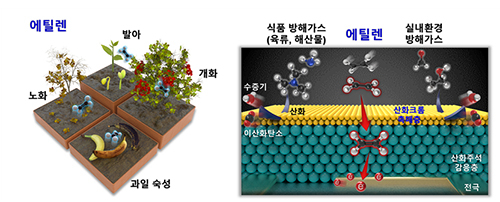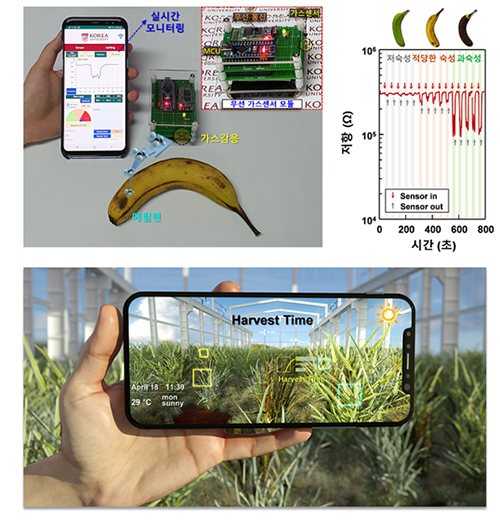“Is my fruit ripening well?” Now you can tell scientifically.
The work by Professor Jong-Heun Lee’s team published in the prominent international journal Advanced Science.
A sensor for detecting the plant hormone ethylene was developed to check the freshness of fruits and evaluate plant growth. The sensor that can detect ethylene in plants will contribute to ‘smart farming.’

▲ (From the left) Seong-Yong Jeong (first author, Ph.D. student); Professor Yun Chan Kang (co-author); and Professor Jong-Heun Lee (corresponding author).
How can we facilitate the ripening of a banana? We can put the banana on top of apples, kiwi fruits and other bananas. Ethylene, the plant hormone from the fruits below, facilitates the ripening of the banana. If you keep a potato with an apple in the same plastic bag, the germination of the potato is suppressed. This is also an effect of the ethylene from the apple. Ethylene has a critical effect on the germination of seeds, the blooming of flowers, and the growth and aging of plants.
*Plant hormone: A regulator produced by plants. Plant hormones can regulate the physiological processes of plants at a low concentration.
Professor Jong-Heun Lee’s team (Department of Materials Science and Engineering, College of Engineering) has successfully developed a new, highly selective and sensitive sensor that can detect ethylene, a representative plant hormone, by introducing a bilayer structure that coats a sensing film of an oxide semiconductor gas sensor with a nanoscale oxide catalytic overlayer.
Selective detection of low-molecular weight ethylene gas by means of oxide semiconductor gas sensors is known to be difficult due to the high bonding energy of the gas.
The research team found that coating the sensing film of a tin oxide (SnO2)-based oxide semiconductor gas sensor with a nanometer-thick catalytic overlayer of chromium oxide (Cr2O3) can enable detection of ethylene with high selectivity and high sensitivity, because the interfering gases, except for ethylene, oxidize with less reactive gases such as carbon dioxide (CO2) and water (H2O). The sensor developed in the present study shows an excellent selectivity to ammonia, dimethylamine and trimethylamine generated from stored meat, seafood and fish as well as various other gases that are present in the indoor environment. Therefore, the sensor can accurately assess fruit ripening regardless of changes in the surrounding environment.
*Oxide semiconductor gas sensors: Sensors based on variation in resistance caused by the response of oxide-based semiconductors (SnO2, ZnO, In2O3, Co3O4, etc.) to reducing and oxidizing gases. Because the oxide semiconductor gas sensors have a high sensitivity and can be easily miniaturized, they can be effectively used to form a sensor network in combination with the Internet of Things, or to create a miniaturized artificial olfactory system consisting of a sensor arrangement.
People have different preferences about the ripeness of fruits. Until now, fruit ripeness has been subjectively evaluated according to the color or texture of the fruit skin. People can estimate fruit ripeness according to how the colors change over time, such as bananas, tomatoes and apple mangos. However, people cannot easily tell how ripe peaches, kiwis and blueberries are based only on color. Therefore, the most objective and scientific way for consumers to accurately determine their desired amount of ripeness is to measure the concentration of ethylene produced by the fruits in small amounts.
The research team measured the concentration of the ethylene from five kinds of fruits (bananas, apple mangos, peaches, kiwis and blueberries) by using the sensor developed in this study, and showed that fruit ripening can be accurately assessed. The research team also achieved real-time monitoring of fruit ripening by transmitting the signals detected by a wireless gas sensor module to another device, such as a smart phone.
Professor Jong-Heun Lee said, “What is most important for applying ICT to farming is selective detection of the small quantity of plant hormone via a wireless communication-based miniaturized sensor. The significance our work is that the plant hormone ethylene was detected at a high selectivity by means of an oxide semiconductor gas sensor that can be easily miniaturized. We hope that we can accelerate the development of such ‘smart farming’ technologies by attaching the sensor to various kinds of plants and monitoring the concentrations of ethylene from the plants through the Internet of Things technology.”
* Smart farming: Cutting-edge agricultural technology created by combining precise farming technologies with ICT, to remotely and automatically manage farming environment and soils and diagnose diseases in greenhouses, orchards and livestock farms.
The present study was led by Seong-Yong Jeong, the first author (Department of Materials Science and Engineering, Korea University), and Professor Yun Chan Kang (Department of Materials Science and Engineering, Korea University) participated in the study as a co-author.
*Authors: Seong-Yong Jeong (first author, Ph.D. student at Korea University), Young Kook Moon (co-author, Master’s student at Korea University), Tae-Hyung Kim (co-author, Ph.D. student at Korea University), Sei-Woong Park, (co-author, Ph.D. student at Korea University), Ki Beom Kim (co-author, Master’s student at Korea University), Yun Chan Kang, (co-author, Professor in the Department of Materials Science and Engineering, Korea University), and Jong-Heun Lee (corresponding author, Professor in the Department of Materials Science and Engineering, Korea University).
The results of the present study were published in Advanced Science, which is a prominent international journal in the field of materials science, on February 24. The study was supported by the Samsung Science & Technology Foundation (Grant No. SRFC-TA1803-04).
*Title of Article: A new strategy for detecting plant hormone ethylene using oxide semiconductor chemiresistors: Exceptional gas selectivity and response tailored by nanoscale Cr2O3 catalytic overlayer.
*Advanced Science: An open-access journal for applications and basic research in materials science applicable to various other fields including physics, chemistry, medicine, life science and engineering. The journal commenced publishing in 2014. According to Thomson JCR (Journal Citation Reports), the impact factor of the journal is 15.804, which is in the top 4.778% of journals in the field of materials science (multidisciplinary) in the world.
[Description of Figures]

Figure 1. (From the left) Effects of ethylene on fruit ripening and plant growth; a schematic diagram of the bilayer sensor; and the principle of selective ethylene gas sensing.

Figure 2. (From top left) Methods of measuring fruit ripeness; and ethylene gas sensing characteristics depending on the ripeness of five kinds of fruits (bananas, apple mangos, peaches, kiwis and blueberries).

Figure 3. (From top left) Real-time fruit ripeness monitoring using a wireless gas sensor module and a smart phone, and gas sensing characteristics; and smart farming technology combined with the Internet of Things technology.



